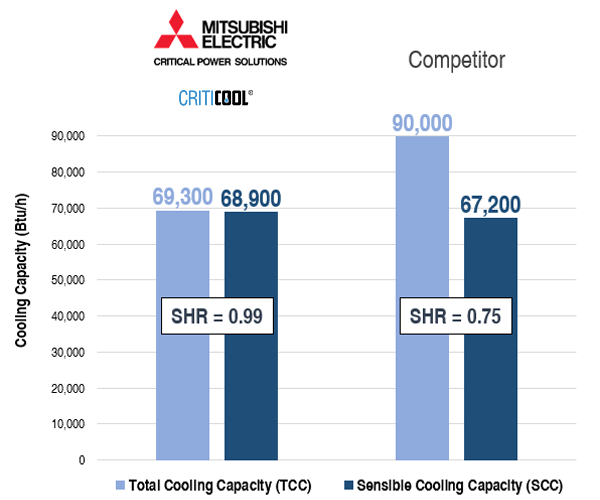BLOG
BLOG
CritiCool® Cooling vs. Comfort Cooling
UPDATED SEPTEMBER 19, 2023
by Mitsubishi Electric Critical Power Solutions' IT Cooling Product Management Team
The data center industry is seeing a shift to pre-fabricated, modular buildings to house electrical equipment for rapid expansion. These unoccupied modular buildings contain critical components that support the data center, such UPS modules, battery systems, switchgear, and static switches.
In the growing edge data center market, these modular buildings may also contain IT equipment, such as network switches and servers. All these components that support our data infrastructure generate heat and need to be cooled to prevent premature equipment failures and costly downtime.
In typical modular building applications, it is very common to see a through-wall comfort cooling product used to cool the building. These through wall coolers are a quality product that can fit a large range of applications, with the intent to make the ambient air suitable and comfortable for occupancy.
But are these products the right fit for keeping our critical infrastructure cool?
The air conditioning unit must reduce the air temperature (Sensible Cooling Capacity, SCC) and remove humidity (Latent Cooling Capacity, LCC). These two parts make up your Total Cooling Capacity (TCC). The relationship between SCC and TCC is called Sensible Heat Ratio (SHR).
SHR = SCC/TCC
Because the electrical equipment is in an unoccupied room and does not generate humidity, you don’t need high latent cooling capacity (in short, the ability to remove moisture from the surrounding environment) that comfort cooling products provide.
For data center applications, it is common to see a SHR from 0.9 to 1.0.
The ideal SHR is 1.0; a higher SHR indicates the better use of energy is being used to cool the electrical equipment. No energy wasted.
Mitsubishi Electric’s CritiCool® product for data center applications, the DX-P, is designed from the ground up for cooling IT and electrical components that can tolerate and function in a wide range of % relative humidity.

So, what’s the big deal if your cooling is comfort vs CritiCool® cooling? Are your critical components at risk? Not necessarily. But it could be costing you money.
- IT Cooling products are designed to run 24/7. Even with N+1 redundancy, why put yourself at risk? If the product is not designed to run 24/7, this could lead to many break-fix instances.
- There are substantial energy savings. The comfort unit is essentially oversized because of the Latent Cooling Capacity; the energy draw on comfort cooling products is higher
- The upfront cost in some cases can be significantly less. Larger comfort cooling products may have a higher upfront cost than the higher SHR product.
If you are looking at modular solutions or shelter applications (such as Telecom or process controls), take a look at your cooling solution and choose the best fit for your application.
Stay up-to-date on industry trends & insights
Be the first notified of new blog posts
By submitting this contact form, you agree that a representative(s) of Mitsubishi Electric Power Products, Inc. (MEPPI) may contact you using the information you provided. In accordance with our Privacy Policy, we will never share or sell your personal data.